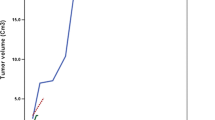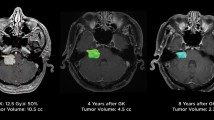Abstract
Purpose
The evidence for treating patients with neurofibromatosis 2-related vestibular schwannoma (VS-NF2) using hypofractionated stereotactic radiation therapy (HSRT) is limited. This study aimed to investigate clinical outcomes in patients with VS-NF2 treated with Robotic HSRT.
Methods
We retrospectively analyzed 25 NF2 patients with 48 VSs who were treated using Robotic HSRT at Ramathibodi Hospital from January 2009 to January 2020.
Results
Median follow-up was 98 months (range, 24–155 months). Median tumor volume was 2.3 cm3 (range, 0.4–28.3 cm3). Median prescribed dose was 18 Gy (range, 18–25 Gy) in three fractions (range, 3–5). The 5- and 10-year local control rates were 87% and 80%, respectively. The 5- and 10-year hearing preservation rates were 59% and 35%, respectively. Three patients developed new symptoms associated with transient volume expansion after treatment: hydrocephalus in one, facial weakness in one, and ataxia in one. No patient developed worsening of trigeminal nerve function. No histologically confirmed of radiation induced malignancy was reported in the study.
Conclusions
Robotic HSRT demonstrated excellent long-term tumor control with a low non-auditory complication rate in patients with VS-NF2. However, preservation of hearing remains a major concern.




Similar content being viewed by others
Data Availability
Tha datasets generated and/or analyzed during the current study are available from the corresponding author on reasonable request.
References
Tamura R (2021) Current understanding of neurofibromatosis type1,2 and schwannomatosis. Int J Mol Sci 22:5850. https://doi.org/10.3390/ijms22115850
Evans DG, Huson SM, Donnai D, Neary W, Blair V, Newton V, Harris R (1992) A clinical study of type 2 neurofibromatosis. Q J Med 84:603–618
Lu VM, Ravindran K, Graffeo CS, Perry A, Van Gompel JJ, Daniels DJ, Link MJ (2019) Efficacy and safety of bevacizumab for vestibular schwannoma in neurofibromatosis type 2: a systematic review and meta-analysis of treatment outcomes. J Neurooncol 144:239–248. https://doi.org/10.1007/s11060-019-03234-8
Andrews DW, Suarez O, Goldman HW et al (2001) Stereotactic radiosurgery and fractionated stereotactic radiotherapy for the treatment of acoustic schwannomas: comparative observations of 125 patients treated at one institution. Int J Radiat Oncol Biol Phys 50:1265–1278. https://doi.org/10.1016/s0360-3016(01)01559-0
Combs SE, Volk S, Schulz-Ertner D, Huber PE, Thilmann C, Debus J (2005) Management of acoustic neuromas with fractionated stereotactic radiotherapy (FSRT): long-term results in 106 patients treated in a single institution. Int J Radiat Oncol Biol Phys 63:75–81. https://doi.org/10.1016/j.ijrobp.2005.01.055
Santa Maria PL, Shi Y, Gurgel RK et al (2019) Long-term hearing outcomes following stereotactic radiosurgery in vestibular Schwannoma Patients-A Retrospective Cohort Study. Neurosurgery 85:550–559. https://doi.org/10.1093/neuros/nyy407
Bin-Alamer O, Faramand A, Alarifi NA et al (2023) Stereotactic radiosurgery for vestibular Schwannoma in neurofibromatosis type 2: an International Multicenter Case Series of Response and Malignant Transformation Risk. Neurosurgery 92:934–944. https://doi.org/10.1227/neu.0000000000002436
Erickson NJ, Schmalz PGR, Agee BS et al (2019) Koos classification of vestibular Schwannomas: a reliability study. Neurosurgery 85:409–414. https://doi.org/10.1093/neuros/nyy409
Gardner G, Robertson JH (1988) Hearing preservation in unilateral acoustic neuroma surgery. Ann Otol Rhinol Laryngol 97:55–66. https://doi.org/10.1177/000348948809700110
House JW, Brackmann DE (1985) Facial nerve grading system. Otolaryngol Head Neck Surg 93:146–147. https://doi.org/10.1177/019459988509300202
Eisenhauer EA, Therasse P, Bogaerts J et al (2009) New response evaluation criteria in solid tumours: revised RECIST guideline (version 1.1). Eur J Cancer 45:228–247. https://doi.org/10.1016/j.ejca.2008.10.026
Dewan R, Pemov A, Kim HJ et al (2015) Evidence of polyclonality in neurofibromatosis type 2-associated multilobulated vestibular schwannomas. Neuro Oncol 17:566–573. https://doi.org/10.1093/neuros/nyy407
Evans DGR, Salvador H, Chang VY et al (2017) Cancer and Central Nervous System Tumor Surveillance in Pediatric neurofibromatosis 2 and related Disorders. Clin Cancer Res 23:e54–e61. https://doi.org/10.1093/neuonc/nou317
Goldbrunner R, Weller M, Regis J et al (2020) EANO guideline on the diagnosis and treatment of vestibular schwannoma. Neuro Oncol 22:31–45. https://doi.org/10.1093/neuonc/noz153
Puataweepong P, Dhanachai M, Swangsilpa T et al (2022) Long-term clinical outcomes of stereotactic radiosurgery and hypofractionated stereotactic radiotherapy using the CyberKnife(®) robotic radiosurgery system for vestibular schwannoma. Asia Pac J Clin Oncol 18:e247–e254. https://doi.org/10.1111/ajco.13592
Goshtasbi K, Abouzari M, Yasaka TM et al (2021) Treatment analysis and overall survival outcomes of patients with bilateral vestibular Schwannoma. Otol Neurotol 42:592–597. https://doi.org/10.1097/MAO.0000000000002984
Johnson S, Kano H, Faramand A, Niranjan A, Flickinger JC, Lunsford LD (2019) Predicting hearing outcomes before primary radiosurgery for vestibular schwannomas. J Neurosurg 1–7. https://doi.org/10.3171/2019.5.JNS182765
Kim J, Byeon Y, Song SW et al (2022) Vestibular schwannoma associated with neurofibromatosis type 2: clinical course following stereotactic radiosurgery. Front Oncol 12:996186. https://doi.org/
Mallory GW, Pollock BE, Foote RL, Carlson ML, Driscoll CL, Link MJ (2014) Stereotactic radiosurgery for neurofibromatosis 2-associated vestibular schwannomas: toward dose optimization for tumor control and functional outcomes. Neurosurgery 74:292–300. https://doi.org/10.1227/NEU.0000000000000264
Shinya Y, Hasegawa H, Shin M et al (2019) Long-term outcomes of stereotactic radiosurgery for vestibular Schwannoma Associated with neurofibromatosis type 2 in comparison to sporadic Schwannoma. Cancers (Basel) 11:1498. https://doi.org/10.3390/cancers11101498
Sri Krishna GS, Pahwa B, Jagdevan A, Singh M, Kale S, Agrawal D (2023) Tumor Control and hearing Preservation after Gamma Knife Radiosurgery for vestibular Schwannomas in neurofibromatosis type 2-A retrospective analysis of 133 tumors. World Neurosurg 171:e820–e827. https://doi.org/10.1016/j.wneu.2022.12.118
Tosi U, Maayan O, An A et al (2022) Stereotactic radiosurgery for vestibular schwannomas in neurofibromatosis type 2 patients: a systematic review and meta-analysis. J Neurooncol 156:431–441. https://doi.org/10.1007/s11060-021-03910-8
Wagner J, Welzel T, Habermehl D, Debus J, Combs SE (2014) Radiotherapy in patients with vestibular schwannoma and neurofibromatosis type 2: clinical results and review of the literature. Tumori 100:189–194. https://doi.org/10.1177/030089161410000212
Meijer OW, Vandertop WP, Lagerwaard FJ, Slotman BJ (2008) Linear accelerator-based stereotactic radiosurgery for bilateral vestibular schwannomas in patients with neurofibromatosis type 2. Neurosurgery 62:A37–42. https://doi.org/10.1227/01.neu.0000325935.23852.9d
Kuo YH, Roos D, Brophy BP (2008) Linear accelerator radiosurgery for treatment of vestibular schwannomas in neurofibromatosis 2. J Clin Neurosci 15:744–748. https://doi.org/10.1016/j.jocn.2007.07.078
Kruyt IJ, Verheul JB, Hanssens PEJ, Kunst HPM (2018) Gamma Knife radiosurgery for treatment of growing vestibular schwannomas in patients with neurofibromatosis type 2: a matched cohort study with sporadic vestibular schwannomas. J Neurosurg 128:49–59. https://doi.org/10.3171/2016.9.JNS161463
Mathieu D, Kondziolka D, Flickinger JC et al (2007) Stereotactic radiosurgery for vestibular schwannomas in patients with neurofibromatosis type 2: an analysis of tumor control, complications, and hearing preservation rates. Neurosurgery 60:460–468 discussion 468–470. https://doi.org/10.1227/01.NEU.0000255340.26027.53
Phi JH, Kim DG, Chung HT, Lee J, Paek SH, Jung HE (2009) Radiosurgical treatment of vestibular schwannomas in patients with neurofibromatosis type 2: tumor control and hearing preservation. Cancer 115:390–398. https://doi.org/10.1002/cncr.24036
Baser ME, Kuramoto L, Woods R et al (2005) The location of constitutional neurofibromatosis 2 (NF2) splice site mutations is associated with the severity of NF2. J Med Genet 42:540–546. https://doi.org/10.1136/jmg.2004.029504
Hall EJ, Brenner DJ (1993) The radiobiology of radiosurgery: rationale for different treatment regimes for AVMs and malignancies. Int J Radiat Oncol Biol Phys 25:381–385. https://doi.org/10.1016/0360-3016(93)90367-5
Buatti JM, Friedman WA, Meeks SL, Bova FJ (1998) The radiobiology of radiosurgery and stereotactic radiotherapy. Med Dosim 23:201–207. https://doi.org/10.1016/s0958-3947(98)00010-7
Safdari H, Fuentes JM, Dubois JB, Alirezai M, Castan P, Vlahovitch B (1985) Radiation necrosis of the brain: time of onset and incidence related to total dose and fractionation of radiation. Neuroradiology 27(1):44–47. https://doi.org/10.1007/BF00342516
Hoban PW, Jones LC, Clark BG (1999) Modeling late effects in hypofractionated stereotactic radiotherapy. Int J Radiat Oncol Biol Phys 43:199–210. https://doi.org/10.1016/s0360-3016(98)00369-1
Combs SE, Welzel T, Schulz-Ertner D, Huber PE, Debus J (2010) Differences in clinical results after LINAC-based single-dose radiosurgery versus fractionated stereotactic radiotherapy for patients with vestibular schwannomas. Int J Radiat Oncol Biol Phys 76:193–200. https://doi.org/10.1016/j.ijrobp.2009.01.064
Fuss M, Debus J, Lohr F, Huber P, Rhein B, Engenhart-Cabillic R, Wannenmacher M (2000) Conventionally fractionated stereotactic radiotherapy (FSRT) for acoustic neuromas. Int J Radiat Oncol Biol Phys 48:1381–1387. https://doi.org/10.1016/s0360-3016(00)01361-4
Kessel KA, Fischer H, Vogel MM et al (2017) Fractionated vs single-fraction stereotactic radiotherapy in patients with vestibular schwannoma; hearing preservation and patients’s self-reported outcome based on an established questionaire. Strahlenther Onkol 193:192–199. https://doi.org/10.1007/s00066-016-1070-0
Lo A, Ayre G, Ma R et al (2018) Population-Based study of stereotactic radiosurgery or fractionated stereotactic radiotherapy for vestibular schwanoma: long-term outcomes and toxicities. Int J Radiat Oncol Biol Phys 100:443–451. https://doi.org/10.1016/j.ijrobp.2017.09.024
Evans DG, Halliday D, Obholzer R et al (2023) Radiation treatment of benign tumors in NF2-related-schwannomatosis: a national study of 266 irradiated patients showing a significant increase in malignancy/malignant progression. Neurooncol Adv 5. https://doi.org/10.1093/noajnl/vdad025
Funding
The authors declare that no funds, grants or other support were received during the preparation of this manuscript.
Author information
Authors and Affiliations
Contributions
All authors contributed to the study conception and design. PP, MD, RR, KB, AH, KS and PY designed study, Material preparation, data collection and analysis were performed by PP, MD, RR, KB, AH, KS and PY. The first draft of the manuscript was written by PP and all authors commented of the manuscript. All authors read and approved the final manuscript.
Corresponding author
Ethics declarations
Competing interests
The authors declare no competing interests.
Ethics approval
The study was performed in the line with the principles of the Declaration of Helsinki. Approval was grant by the institutional review board of Ramathibodi Hospital.
Additional information
Publisher’s Note
Springer Nature remains neutral with regard to jurisdictional claims in published maps and institutional affiliations.
Electronic supplementary material
Below is the link to the electronic supplementary material.
Rights and permissions
Springer Nature or its licensor (e.g. a society or other partner) holds exclusive rights to this article under a publishing agreement with the author(s) or other rightsholder(s); author self-archiving of the accepted manuscript version of this article is solely governed by the terms of such publishing agreement and applicable law.
About this article
Cite this article
Puataweepong, P., Dhanacha, M., Ruangkanchanasetr, R. et al. Long-term clinical outcomes of stereotactic radiotherapy for bilateral vestibular schwannomas in neurofibromatosis type 2 patients. J Neurooncol 164, 587–595 (2023). https://doi.org/10.1007/s11060-023-04430-3
Received:
Accepted:
Published:
Issue Date:
DOI: https://doi.org/10.1007/s11060-023-04430-3




